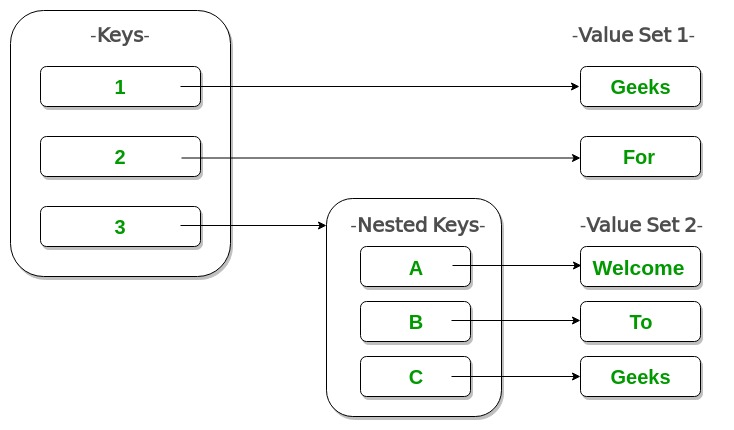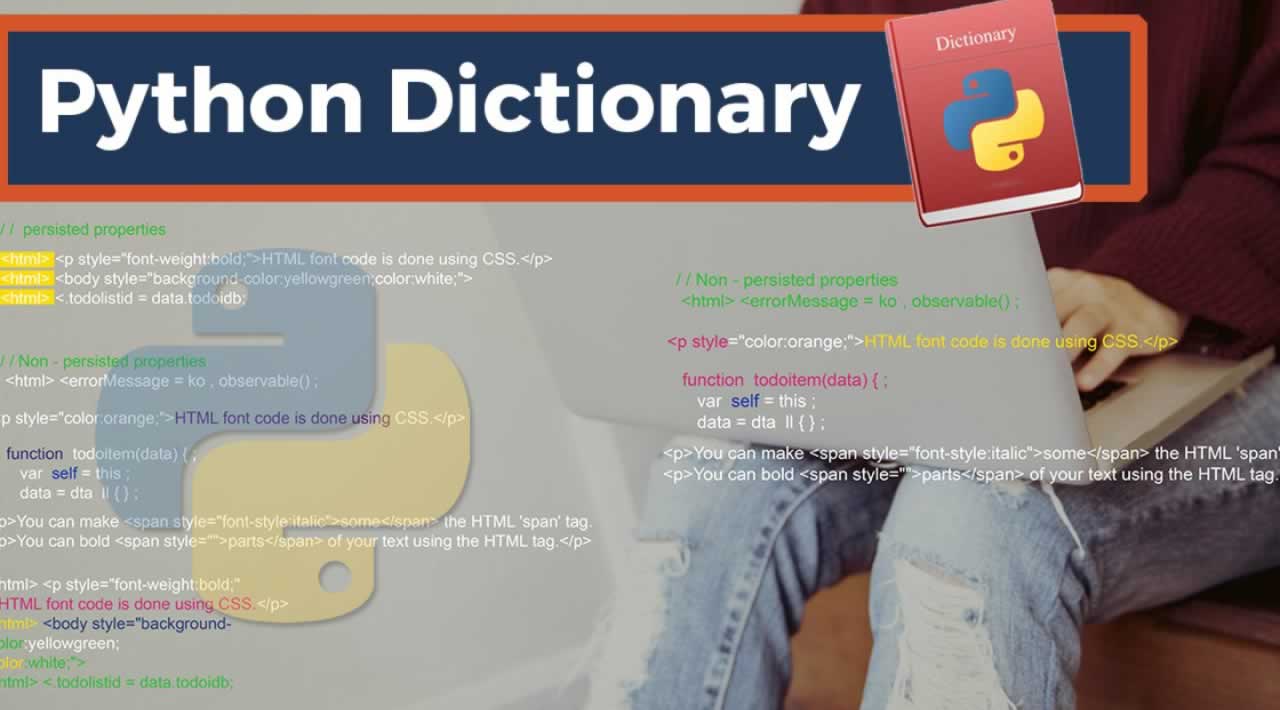A guide to Python Dictionaries
Dictionary in Python is an unordered collection of data values, used to store data values like a map, which unlike other Data Types that hold only single value as an element, Dictionary holds key:value pair. Key value is provided in the dictionary to make it more optimized. Each key-value pair in a Dictionary is separated by a colon :, whereas each key is separated by a ‘comma’.
A Dictionary in Python works similar to the Dictionary in a real world. Keys of a Dictionary must be unique and of immutable data type such as Strings, Integers and tuples, but the key-values can be repeated and be of any type.
Note – Keys in a dictionary doesn’t allows Polymorphism.
Creating a Dictionary
In Python, a Dictionary can be created by placing sequence of elements within curly {} braces, separated by ‘comma’. Dictionary holds a pair of values, one being the Key and the other corresponding pair element being its Key:value. Values in a dictionary can be of any datatype and can be duplicated, whereas keys can’t be repeated and must be immutable.
Dictionary can also be created by the built-in function dict(). An empty dictionary can be created by just placing to curly braces{}.
Note – Dictionary keys are case sensitive, same name but different cases of Key will be treated distinctly.
# Creating an empty Dictionary
Dict = {}
print("Empty Dictionary: ")
print(Dict)
# Creating a Dictionary
# with Integer Keys
Dict = {1: 'Geeks', 2: 'For', 3: 'Geeks'}
print("\nDictionary with the use of Integer Keys: ")
print(Dict)
# Creating a Dictionary
# with Mixed keys
Dict = {'Name': 'Geeks', 1: [1, 2, 3, 4]}
print("\nDictionary with the use of Mixed Keys: ")
print(Dict)
# Creating a Dictionary
# with dict() method
Dict = dict({1: 'Geeks', 2: 'For', 3:'Geeks'})
print("\nDictionary with the use of dict(): ")
print(Dict)
# Creating a Dictionary
# with each item as a Pair
Dict = dict([(1, 'Geeks'), (2, 'For')])
print("\nDictionary with each item as a pair: ")
print(Dict)
Output:
Empty Dictionary:
{}
Dictionary with the use of Integer Keys:
{1: 'Geeks', 2: 'For', 3: 'Geeks'}
Dictionary with the use of Mixed Keys:
{1: [1, 2, 3, 4], 'Name': 'Geeks'}
Dictionary with the use of dict():
{1: 'Geeks', 2: 'For', 3: 'Geeks'}
Dictionary with each item as a pair:
{1: 'Geeks', 2: 'For'}
Nested Dictionary:

# Creating a Nested Dictionary
# as shown in the below image
Dict = {1: 'Geeks', 2: 'For',
3:{'A' : 'Welcome', 'B' : 'To', 'C' : 'Geeks'}}
print(Dict)
Output:
{1: 'Geeks', 2: 'For', 3: {'A': 'Welcome', 'B': 'To', 'C': 'Geeks'}}
Adding elements to a Dictionary
In Python Dictionary, Addition of elements can be done in multiple ways. One value at a time can be added to a Dictionary by defining value along with the key e.g. Dict[Key] = ‘Value’. Updating an existing value in a Dictionary can be done by using the built-in update() method. Nested key values can also be added to an existing Dictionary.
Note- While adding a value, if the key value already exists, the value gets updated otherwise a new Key with the value is added to the Dictionary.
# Creating an empty Dictionary
Dict = {}
print("Empty Dictionary: ")
print(Dict)
# Adding elements one at a time
Dict[0] = 'Geeks'
Dict[2] = 'For'
Dict[3] = 1
print("\nDictionary after adding 3 elements: ")
print(Dict)
# Adding set of values
# to a single Key
Dict['Value_set'] = 2, 3, 4
print("\nDictionary after adding 3 elements: ")
print(Dict)
# Updating existing Key's Value
Dict[2] = 'Welcome'
print("\nUpdated key value: ")
print(Dict)
# Adding Nested Key value to Dictionary
Dict[5] = {'Nested' :{'1' : 'Life', '2' : 'Geeks'}}
print("\nAdding a Nested Key: ")
print(Dict)
Output:
Empty Dictionary:
{}
Dictionary after adding 3 elements:
{0: 'Geeks', 2: 'For', 3: 1}
Dictionary after adding 3 elements:
{0: 'Geeks', 2: 'For', 3: 1, 'Value_set': (2, 3, 4)}
Updated key value:
{0: 'Geeks', 2: 'Welcome', 3: 1, 'Value_set': (2, 3, 4)}
Adding a Nested Key:
{0: 'Geeks', 2: 'Welcome', 3: 1, 5: {'Nested': {'1': 'Life', '2': 'Geeks'}}, 'Value_set': (2, 3, 4)}
Accessing elements from a Dictionary
In order to access the items of a dictionary refer to its key name.Key can be used inside square brackets.There is also a method called get() that will also help in acessing the element from a dictionary.
# Python program to demonstrate
# accesing a element from a Dictionary
# Creating a Dictionary
Dict = {1: 'Geeks', 'name': 'For', 3: 'Geeks'}
# accessing a element using key
print("Acessing a element using key:")
print(Dict['name'])
# accessing a element using key
print("Acessing a element using key:")
print(Dict[1])
# accessing a element using get()
# method
print("Acessing a element using get:")
print(Dict.get(3))
Output:
Acessing a element using key:
For
Acessing a element using key:
Geeks
Acessing a element using get:
Geeks
Removing Elements from Dictionary
In Python Dictionary, deletion of keys can be done by using the del keyword. Using del keyword, specific values from a dictionary as well as whole dictionary can be deleted. Other functions like pop() and popitem() can also be used for deleting specific values and arbitrary values from a Dictionary. All the items from a dictionary can be deleted at once by using clear() method. Items in a Nested dictionary can also be deleted by using del keyword and providing specific nested key and particular key to be deleted from that nested Dictionary.
Note- del Dict will delete the entire dictionary and hence printing it after deletion will raise an Error.
# Initial Dictionary
Dict = { 5 : 'Welcome', 6 : 'To', 7 : 'Geeks',
'A' : {1 : 'Geeks', 2 : 'For', 3 : 'Geeks'},
'B' : {1 : 'Geeks', 2 : 'Life'}}
print("Initial Dictionary: ")
print(Dict)
# Deleting a Key value
del Dict[6]
print("\nDeleting a specific key: ")
print(Dict)
# Deleting a Key from
# Nested Dictionary
del Dict['A'][2]
print("\nDeleting a key from Nested Dictionary: ")
print(Dict)
# Deleting a Key
# using pop()
Dict.pop(5)
print("\nPopping specific element: ")
print(Dict)
# Deleting an arbitrary Key-value pair
# using popitem()
Dict.popitem()
print("\nPops an arbitrary key-value pair: ")
print(Dict)
# Deleting entire Dictionary
Dict.clear()
print("\nDeleting Entire Dictionary: ")
print(Dict)
Output:
Initial Dictionary:
{'A': {1: 'Geeks', 2: 'For', 3: 'Geeks'}, 'B': {1: 'Geeks', 2: 'Life'}, 5: 'Welcome', 6: 'To', 7: 'Geeks'}
Deleting a specific key:
{'A': {1: 'Geeks', 2: 'For', 3: 'Geeks'}, 'B': {1: 'Geeks', 2: 'Life'}, 5: 'Welcome', 7: 'Geeks'}
Deleting a key from Nested Dictionary:
{'A': {1: 'Geeks', 3: 'Geeks'}, 'B': {1: 'Geeks', 2: 'Life'}, 5: 'Welcome', 7: 'Geeks'}
Popping specific element:
{'A': {1: 'Geeks', 3: 'Geeks'}, 'B': {1: 'Geeks', 2: 'Life'}, 7: 'Geeks'}
Pops an arbitrary key-value pair:
{'B': {1: 'Geeks', 2: 'Life'}, 7: 'Geeks'}
Deleting Entire Dictionary:
{}
#python
